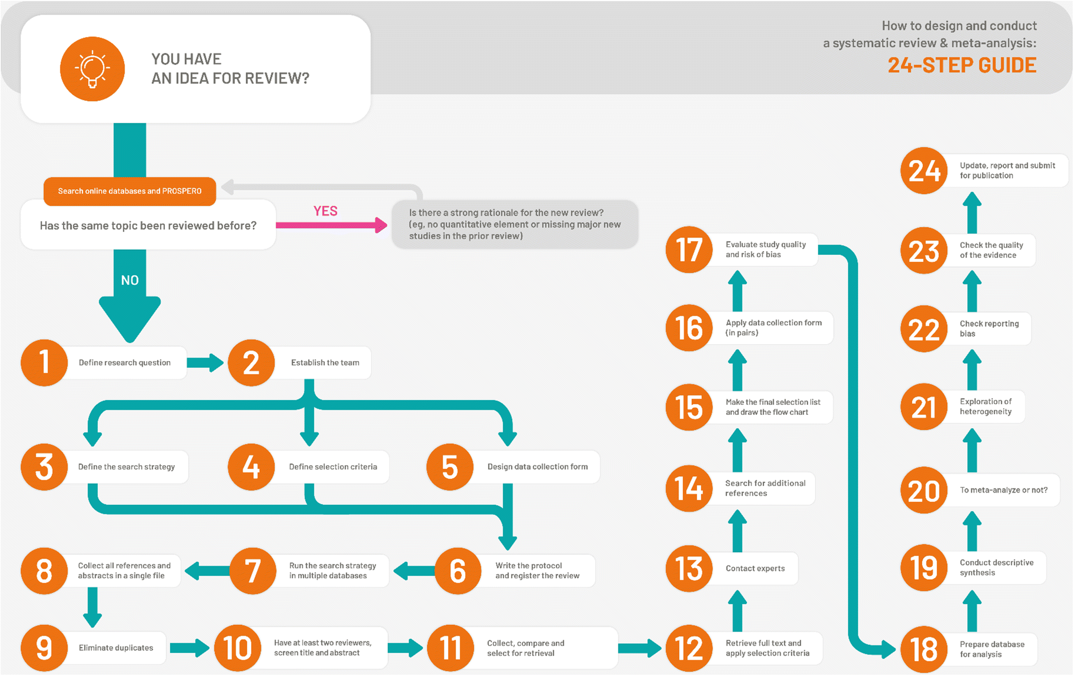5 Seminar Four

How to design and conduct a systematic review - 24 step process
In the lecture this week you will have learnt about strategies for advanced data extraction. Whilst this step can take a significant amount of time to complete, the findings of a systematic review depend critically on decisions relating to which data from these studies are presented and analysed, it therefore poses an important step in the review process.
5.1 Task 1
Open the data extraction template. NB: This template can be used and adapted for any review you do of the literature.
Open the link to one of the studies below and complete a row of the data extraction template
- Reid, A., Birmingham, T. B., & Alcock, G. (2007). Efficacy of mobilization with movement for patients with limited dorsiflexion after ankle sprain: a crossover trial. Physiotherapy Canada, 59(3), 166-172.
- Vicenzino, B., Branjerdporn, M., Teys, P., & Jordan, K. (2006). Initial changes in posterior talar glide and dorsiflexion of the ankle after mobilization with movement in individuals with recurrent ankle sprain. Journal of Orthopaedic & Sports Physical Therapy, 36(7), 464-471.
- Collins, N., Teys, P., & Vicenzino, B. (2004). The initial effects of a Mulligan’s mobilization with movement technique on dorsiflexion and pain in subacute ankle sprains. Manual therapy, 9(2), 77-82.
- Green, T., Refshauge, K., Crosbie, J., & Adams, R. (2001). A randomized controlled trial of a passive accessory joint mobilization on acute ankle inversion sprains. Physical therapy, 81(4), 984-994.
- Borromeo, C. N., Ryan, J. L., Marchetto, P. A., Peterson, R., & Bove, A. A. (1997). Hyperbaric oxygen therapy for acute ankle sprains. The American journal of sports medicine, 25(5), 619-625.
5.2 Task 2
Every review is slightly different and the information that is needed to answer each review question will differ. Therefore, take some time to think about what information is needed for the systematic review you are undertaking. It is useful using the PICOS framework when planning what data will need extraction. Using the wording below construct your own data extraction plan and add this to your protocol:
One author (initials) will independently extract data from all included studies, another (initials) will validate the data extracted. Data will be extracted using a standardised data collection form and includes the following items:
- General Information; Review title, study ID, date form completed, name of data extractor, study citation, publication type
- Methods; Study aim, study design, unit of allocation, start date, end date, duration of participation, ethical approval
- Participants; Population description, setting, inclusion criteria, exclusion criteria, recruitment method, consent obtained, total number randomised, baseline imbalances, withdrawals & exclusions, age, sex, race, illness severity, co-morbidities, other sociodemographics, subgroup measures, subgroups reported
- Intervention; Name, number randomised, theoretical basis, description, duration, timing, delivery, providers, co-interventions, integrity of delivery, compliance
- Outcomes; Name, time points measured, time points reported, definition, person measuring/reporting, unit of measurement, outcome validation, imputation of missing data, assumed risk estimate, power
- Dichotomous Findings; Comparison, outcome, subgroup, time point, number with event in intervention, total number in intervention, number with event in comparison, total number in comparison, results reported (risk difference, risk ratio, odds ratio, confidence interval, p-value), number of missing participants, reasons for missing, unit of analysis, statistical methods
- Continuous Findings; Comparison, outcome, subgroup, time point, post intervention or change from baseline, intervention mean, intervention standard deviation and total number in intervention, comparison mean, comparison standard deviation and total number in comparison, results reported (mean difference, confidence interval, p-value, number of missing participants, reasons for missing, unit of analysis, statistical methods
5.3 Task 3
Download the data extraction form to your own onedrive and amend using using the details outlined in your protocol.
5.4 Task 4
Pilot your data extraction form by completing one entry using an article that meets your systematic review eligibility.
5.5 Additional reading
Munn, Z., Tufanaru, C., & Aromataris, E. (2014). JBI’s systematic reviews: data extraction and synthesis. AJN The American Journal of Nursing, 114(7), 49-54.